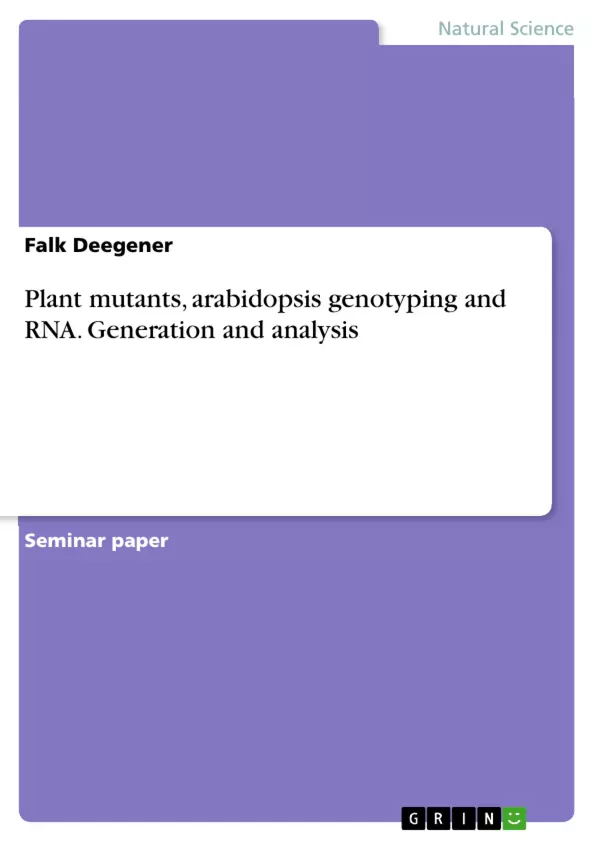This paper investigates and detects the resulting changes of the genome by using genotyping.
Manipulating an organism’s genome usually includes the insertion of an DNA fragment. This insertion can be of many different kinds, with several effects on the gene expression of the organism. Depending on the position of the insertion, it can result in a knock-out, knock-down, no effect or even an overexpression of the gene it was inserted into.
With genotyping it is possible to detect differences in the genome of an organism compared to another individual. Therefore, no DNA-sequence is defined, but only the difference between two genomes. Also, it is not necessary to define an individual’s genes. If one compares the genome of a genetically engineered organism with the wild type, it is possible to determine if and where the insertion took place, since a difference in their genomes should be detected at the locus of insertion (Kennedy et al., 2003).
There are many different methods with which genotyping can be performed. For this experiment, we used the polymerase chain reaction (PCR). This method includes the exponential amplification of very small DNA amounts in a series of temperature cycles. These cycles of low and high temperatures are performed by a machine called thermocycler.
The reactants that are loaded together into the thermocycler include a double-stranded DNA template that should be amplified, nucleotides that are the building blocks of the DNA, DNA polymerase that assembles the nucleotides and primers that bind the template DNA and define the starting points for the polymerase. In the first step, the thermocycler heats the reactants to denature the DNA and therefore separate the double strands into single strands. In the second step, the temperature is lowered to allow primers to bind the single stranded DNA.
These single strands now serve as templates for the DNA polymerase that binds the primers and assembles new complementary strands using the free nucleotides in the solution. Then, the thermocycler heats up the reactants and the cycle starts all over again, but with a doubled amount of template DNA, which therefore exponentially amplifies (Saiki et al., 1985).
The resulting amplification products are then compared on an agarose gel to detect differences in the genome of the organisms.
Inhaltsverzeichnis (Table of Contents)
- Introduction
- Genotyping with PCR
- Sanger Sequencing
- Material and Methods
- Results
- Discussion
- Literature
Zielsetzung und Themenschwerpunkte (Objectives and Key Themes)
This experiment focuses on the generation of plant mutants using CRISPR/Cas9 technology and the subsequent analysis of the genetic modifications. The main goal is to identify and characterize the effects of the gene editing process on the target gene, RS31, and its expression.
- Genotyping with PCR and Sanger Sequencing
- Detection and characterization of gene mutations
- Analysis of gene expression following gene editing
- Comparison of wild-type and mutant genotypes
- Application of CRISPR/Cas9 technology for plant mutagenesis
Zusammenfassung der Kapitel (Chapter Summaries)
- Introduction: This chapter introduces the concept of genotyping, highlighting its importance in detecting changes in an organism's genome. It discusses the polymerase chain reaction (PCR) as a method for genotyping, explaining the underlying principles and steps involved. The chapter also introduces Sanger sequencing, another method for characterizing DNA mutations, emphasizing its utility for precise analysis of insertions and deletions.
- Material and Methods: This section outlines the experimental procedures employed in the study. It details the plant materials used, including wild-type and mutant genotypes, and the methods for extracting genomic DNA and amplifying specific DNA regions using PCR. It also describes the subsequent sequencing of PCR products and RNA isolation and analysis.
Schlüsselwörter (Keywords)
This work focuses on the application of CRISPR/Cas9 technology for gene editing in plants, specifically targeting the RS31 gene. The study utilizes genotyping techniques such as PCR and Sanger sequencing to detect and characterize mutations induced by the gene editing process. RNA analysis further explores the impact of these mutations on gene expression. Key concepts include plant mutagenesis, CRISPR/Cas9, genotyping, Sanger sequencing, and gene expression.
- Quote paper
- Falk Deegener (Author), 2020, Plant mutants, arabidopsis genotyping and RNA. Generation and analysis, Munich, GRIN Verlag, https://www.grin.com/document/1131628



